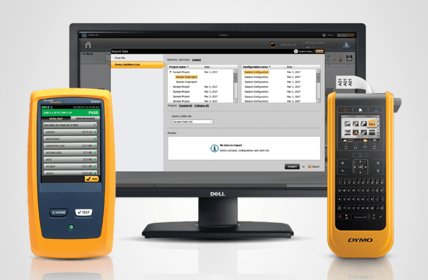 So, what do Infrastructure Circuit Testing and Labeling have in common? They are both critical for the understanding, maintaining and running of critical operations for businesses large and small.
So, what do Infrastructure Circuit Testing and Labeling have in common? They are both critical for the understanding, maintaining and running of critical operations for businesses large and small.
Why do we require testing?
- To ensure that the infrastructure was installed correctly.
- To provide confidence that the applications running over the network will be supported.
- To ensure that the installed infrastructure meets required TIA standards.
- To provide network certification and compliance.
Why do we require labeling?
- It ensures the ease of administration of the network infrastructure.
- It saves time for MAC's.
- It is required by the TIA standards.
How can we combine the testing and labeling?
The TIA Standards require an identifier be assigned to every link (circuit) in the building infrastructure. This identifier is used for testing and labeling and becomes a key factor for the administration of the building infrastructure.
Before a link can be tested, an identifier must be created for each cable. This same identifier is used for labeling, which in most cases must be manually entered into a label printer. This duplicate data entry is time consuming and can lead to possible entry errors.
To streamline this process, DYMO and Fluke Networks have entered a partnership which eliminates steps and saves installation contractors time when testing and labeling.
DYMO ID software, now with LinkWare Live integration, imports project data directly from the LinkWare Live cloud-based service to provide a simplified solution for cable label creation.
Before the links are tested, an installer must create the cable identifiers for the link in LinkWare Live. This identifier is used for testing and labeling the link. With the integration of LinkWare Live and DYMO ID, an installer no longer needs to enter the link identifier multiple times for testing and labeling. The identifier can be entered once for test set up in LinkWare Live and imported directly into DYMO ID, saving the installer time when testing and labeling network links.
This time-saving feature allows the installation contractor to be much more efficient, saving money and increasing productivity. DYMO ID with LinkWare Live integration is ideal for project managers, cable technicians and installers.
A review of the key benefits of integration with DYMO ID:
- Quickly connect to LinkWare Live to access and view the most recent project data;
- Import data from a LinkWare Live account to eliminate manual entry, saving time and increasing productivity;
- Avoid manual and duplicate entry of Cable IDs as well as reduce potential for wasted labels;
- Use Cable ID data with built-in label application and time-saving templates for patch panels, wire/cable labels and more;
- Life-like on-screen print preview shows how labels will look when applied to cables, panels and more; and
- Print directly or transfer labels to an XTL label maker for editing and printing in the field.


.png?width=58&height=58&name=X_logo_2023_(white).png)
